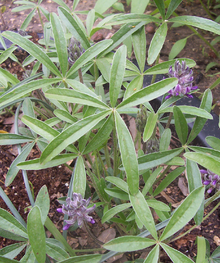| This article includes a list of references, related reading, or external links, but its sources remain unclear because it lacks inline citations. Please help improve this article by introducing more precise citations. (March 2013) (Learn how and when to remove this message) |
| Pediomelum hypogaeum | |
|---|---|

| |
| Conservation status | |
 Secure (NatureServe) | |
| Scientific classification | |
| Kingdom: | Plantae |
| Clade: | Tracheophytes |
| Clade: | Angiosperms |
| Clade: | Eudicots |
| Clade: | Rosids |
| Order: | Fabales |
| Family: | Fabaceae |
| Subfamily: | Faboideae |
| Genus: | Pediomelum |
| Species: | P. hypogaeum |
| Binomial name | |
| Pediomelum hypogaeum (Nutt.) Rydb. | |
Pediomelum hypogaeum (also known as Psoralea hypogaea) is a perennial herb also known as the little Indian breadroot or subterranean Indian breadroot. It is found on the black soil prairies in Texas.
Growth
It has an inflorescence on stems 5-6 centimeters long, separate from the leaves, arising from a subterranean stem and deep carrot-shaped root that is 3–7 cm long. The long petioled leaves are palmately divided into 5 linear-elliptic leaflets that are 3-5 centimeters long. The flowers, borne in condensed spikes separate from the leaves, are purple and pea-like, and have a surprisingly strong scent, reminiscent of lemon furniture polish. The species has edible tuberous roots, high in protein.
References
- NatureServe (2024). "Pediomelum hypogaeum". Arlington, Virginia. Retrieved 27 July 2024.
- Delena Tull (1987), Edible and Useful Plants of Texas and the Southwest, pgs 86-87
External links
- United States Department of Agriculture Natural Resources Conservation Service. PLANTS Profile: Pediomelum hypogaeum...subterranean Indian breadroot
- Texas A&M Bioinformatics Working Group. Texas Endemics: Distribution of Pediomelum hypogaeum var. scaposum Archived 2004-08-25 at the Wayback Machine
| Taxon identifiers | |
|---|---|
| Pediomelum hypogaeum |
|
This Faboideae-related article is a stub. You can help Misplaced Pages by expanding it. |